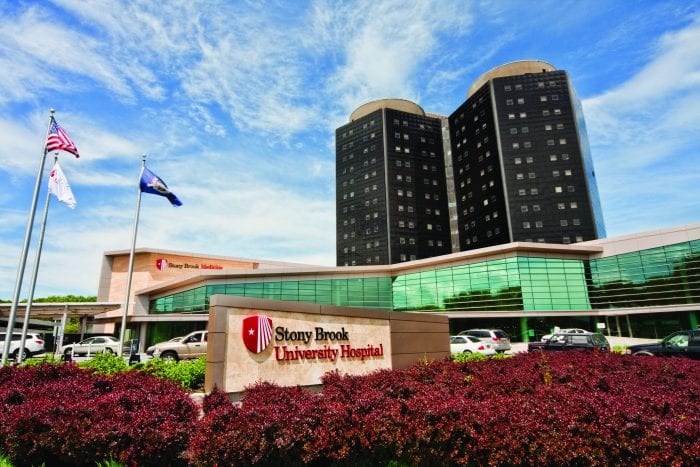SBU/Huntington Say ‘It’s Safe to Come Back,’ Open for Patient Care
Suffolk hospitals are slowly getting back to some normalcy as the number of COVID-19 patients continue to decrease on Long Island. As hospitals have gotten past the peak of the pandemic, they are now facing the challenge of reassuring the public that their facilities are safe.
“I think it is incredibly important that people feel comfortable and safe whether it’s seeing their personal physician or coming to the hospital,” said Dr. Susan Donelan, medical director, Department of Infectious Diseases, Renaissance School of Medicine at Stony Brook University.

Photo from Axelrod
Donelan said SBU Hospital has implemented a number of protocols to ensure worker and patient safety. For individuals that are going to outpatient centers and physician offices, they are advised to remain in their vehicles and complete their normal check-in process using their cellphones. Waiting rooms are arranged to allow for optimal social distancing.
The medical director said they hope to quell any fears patients may have.
“Patients shouldn’t suspend any routine health procedures — I think it is a safe and a good time to come back,” Donelan said.
For those that come to the hospital for a procedure, patients will have a conversation with a triage nurse over the phone before they come in. They will undergo temperature checks and screened for COVID symptoms. Patients suspected of having coronavirus are separated from other patients.
“We’ve increased our cleaning frequency, we want to make sure our patients and workers are entering a safe environment,” Donelan said.
Like other facilities, SBU Hospital has made adjustments to its visitor policy in an effort to limit potential exposure. Currently, only one visitor can visit a patient and are only allowed a three-hour time window.
Donelan said the feedback they’ve gotten from staff and patients on their safety measures has been positive.
“We’ve been pleased with the feedback, they have appreciated our aggressive approach and attention to detail,” she said.
Dr. Nick Fitterman, executive director of Huntington Hospital, said they are trying to get word out to the public that its facilities are safe and stressed the need for individuals to seek out medical care.
“March and April, we were all hands on deck,” he said. “We went from having around 300 COVID-19 cases to now only having six.”
Fitteram understands the public concerns of returning but said they have created essentially a “hospital within a hospital,” where COVID patients are isolated in another section of the building away from non-COVID patients.
“COVID patients are assigned nurses and doctors that only treat them, they do not see any other patients,” Fitterman said.
The hospital has implemented thermal cameras used to help check temperatures of staff, patients and visitors. Workers are screened daily for COVID symptoms. Fitterman said that they are limiting visiting hours and allow only one visitor per patient.
“It is important not only to protect the patients but to protect our staff as well,” he said.
Nancy Axelrod, of Old Field, said she can attest to the hospital’s safety protocols. With elective surgeries allowed again, Axelrod was able to get right knee replacement surgery last month. She underwent left knee replacement surgery right before COVID hit Long Island.
“It was something I needed to get done, I’ve suffered from severe arthritis,” she said. “From talking to the doctors, I felt strongly that I was safe.”
Huntington Hospital had about 1,000 surgeries that were put on hold. In an effort to keep patients safe, they have installed a separate “pathway” for them when they get to the hospital.
Axelrod said she had to go through a number of tests and screening before the surgery.
“I would tell people not to put off seeing your doctor or getting an important surgery,” she said. “The time to do it is now — I feel that the hospital is doing an awful lot to ensure patient safety.”







